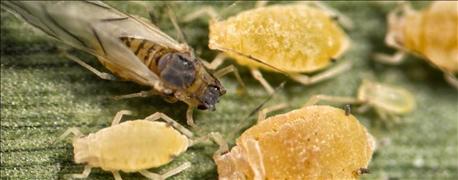June 9, 2016

Sulfoxaflor, the active ingredient in Transform WG, a Dow AgroSciences product, now has government approval for use in Nebraska to treat sugarcane aphids in sorghum during the 2016 growing season.
This Section 18 emergency use exemption granted by EPA now brings Nebraska in line with 13 other sorghum-producing states that have previously been approved.
"Sorghum growers in Alabama, Arkansas, Georgia, Kansas, Louisiana, Mississippi, Missouri, Nebraska, North Carolina, Oklahoma, South Carolina, Tennessee, Texas, and Virginia are now better equipped to manage the sugarcane aphid and minimize yield and revenue loss," said Barbara Kliment, executive director for the Nebraska Grain Sorghum Board.

BE PROACTIVE: Sugarcane aphid has demonstrated it is capable of causing substantial crop damage if not managed properly. It was first discovered late in the 2013 growing season in the coastal sorghum-growing regions. Photo credit: Patrick Porter, Texas Cooperative Extension, Bugwood.org
"While occurrence of the sugarcane aphid has not to date been reported in Nebraska, it is notable that the infestation was substantial in Kansas last year and nearly encroached into our state," Kliment added. "For that reason, we felt it was necessary to request the Section 18 Exemption as a precautionary measure to make certain our growers had the resources necessary to control the pest should it get here."
A new pest in the industry
The sugarcane aphid is a new pest to the U.S. sorghum industry, having been first discovered late in the 2013 growing season in the coastal sorghum-growing regions. The insect has demonstrated that it is capable of causing substantial crop damage if not managed properly. As with any insect, it is important for producers to be proactive and consistent in scouting for and monitoring their fields. Early detection is critical to minimize the aphid's harmful effects.
Sugarcane aphids are gray, tan or pale yellow. A pair of black cornicles or tailpipes can be seen on the aphid's back end, and tips of feet and antennae are black. Colonies are usually clustered around the midrib of the bottom side of the sorghum leaf. Sugarcane aphids are also prolific producers of honeydew – a key indicator of an aphid infestation is leaves covered with a sticky, shiny honeydew.
When the insect was first identified in sorghum, great effort was taken to network through the United Sorghum Checkoff Program, National Sorghum Producers, and state affiliates to work with universities and extension to educate producers on the necessary identification, scouting and management protocol. That work continues.
Impact on the Southern Plains
This season the sugarcane aphid has been reported in varying degrees of infestation across sorghum growing areas of Texas. Overall growers and crop consultants have done a good job of scouting and controlling the insect, as needed, Kliment said. As a result yield potential is good throughout the area. Field monitoring is ongoing to track the aphid's migration.
Sorghum growers are encouraged to employ best management practices that include using a seed treatment, planting tolerant hybrids early, and conducting timely field scouting. To learn more, a link to detailed information on identification and management of sugarcane aphids is in the CropWatch Sorghum section and on the United Sorghum Checkoff Program website.
Sources: UNL CropWatch, Nebraska Grain Sorghum Board
You May Also Like




